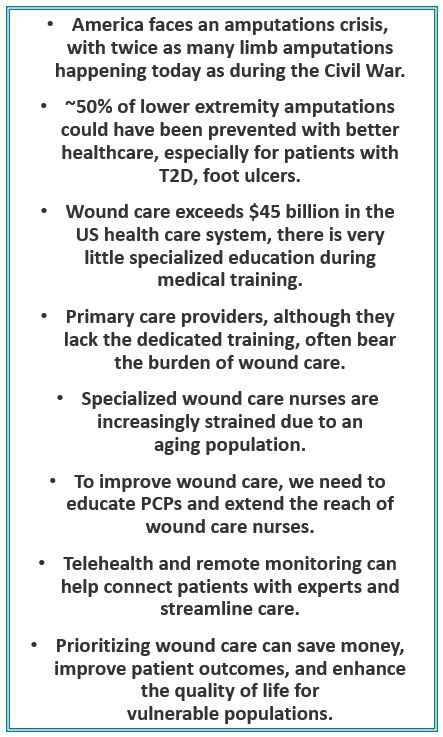Why is Wound Care Falling to Primary Care?
Despite medical advances, Americans are facing an amputation crisis. We’re amputating two times more limbs than we did during the entire civil war, and approximately 50% of lower extremity amputations could have been prevented if patients with type 2 diabetes and foot ulcers had access to better health care.
The cost of caring for all wounds in the US healthcare system is over $45 billion. With such a costly problem, you would think we’d dedicate more specialized resources to treating it.
Nima Ahmadi, CEO, cofounder, The Wound Co.
Courtesy of The Wound Co.
Courtesy of The Wound Co.

Yet, in medical school, there is no wound care learning track. Unfortunately, we offload the burden of tending to wounds and ostomies to primary care providers without offering the dedicated, comprehensive education needed to become an expert at providing this type of care. For doctors and nurses who are already overworked, it’s ridiculous that the onus falls on them. The true frontline experts in wound and ostomy care are specialized nurses who have spent years cultivating an understanding of the rigorous treatment needed to fend off downward spirals that an unhealed, infected wound or an untreated diabetic pressure ulcer can prompt.
Up against an aging population, this small but mighty group is increasingly strained. PCPs will continue to be the first line of defense in wound care, regardless of how we expand our education. The best way to maximize outcomes here is to approach the problem from both angles – expanding PCP understanding of wound and ostomy care and amplifying the reach of dedicated wound and ostomy nurses.
What to know as a PCP
The lack of specialized wound care expertise within the PCP base, transitional care units (TCU) and skilled nursing facilities (SNF), home care, and hospice centers translates into challenging circumstances for patients to get appropriate, timely wound care and preventive support. Stretched resources leave patients with little access to specialized resources that they can consult and no continuous monitoring of their wounds, thus encouraging sporadic, almost desperate treatments late in the care continuum, followed by a cycle of new wounds or deterioration.
The day-to-day of dealing with a wound is challenging for individual patients and their families. Wounds that aren’t appropriately treated can be painful, smelly, and debilitating. At their most vulnerable when seeking wound care, patients are left with the onus of making the most of their time, doing their best to synthesize how to treat themselves, and hoping that the wound doesn’t get worse between doctor visits.
On top of this, patients and PCPs need to work through which treatments and products are actually valuable in treating wounds. Many wound care-focused companies have been seen to push too many medically unnecessary and expensive treatments, such as excess hyperbaric oxygen therapy and skin substitute applications, without clinical impact, especially in the absence of longitudinal engagement by a wound care expert and timely intervention. The lack of education around wound care and the scale of the suffering leads to a longer leash for these companies, which can get away with these practices for longer than they should because the people prescribing the products and the people being treated are similarly in the dark about the standard for wound care.
How we can amplify WOC nurses
We can make significant improvements to wound and ostomy care by providing better educational resources to guide on-the-ground staff, extending the reach of certified wound, ostomy, and continence (WOC) nurses that already exist, and implementing predictive analytics technology to ensure the right wound care is delivered to the right patient at the right time.

First, enhancing educational resources is crucial to equip healthcare professionals with the necessary knowledge and skills to provide optimal wound and ostomy care. Expanding the number of PCPs and nurses trained in wound assessment, wound treatment techniques, and wound management will exponentially increase the positive patient outcomes realized. By investing in ongoing education and professional development, healthcare staff can stay up-to-date with the latest advancements in wound care and deliver evidence-based practices.
Second, we already have many incredible WOC nurses. Leveraging their unique, interdisciplinary expertise, built by managing different patients across various care settings with unique wounds and circumstances, gives them an agile and adaptable knowledge base. We can bring the expertise of these WOC nurses to underserved facilities via technology. Through a connected platform, these experts can provide detailed advice and guidance to on-the-ground staff. This process additionally helps to build the abilities of those receiving the guidance.
Finally, technology can facilitate efficient patient check-ups and promote timely interventions. Telehealth platforms and remote monitoring can ensure that the presiding staff is tuned in to the patients most in need. By expanding the care base for those with wounds and automating care schedules, patients struggle less to connect with providers and receive prompt attention and interventions when necessary and earlier in the pathophysiology of their wounds. The onus of care falls back into the hands of those most capable of providing care.
The Wound Company
I co-founded a company called The Wound Company to directly advance wound care by bringing wound care expert nurses to the patients and providers that need their support early and continuously.
In my personal journey, I have had family members suffer bilateral amputations due to lower extremity wounds. This inspired me to spend time in Guatemala building prosthetic implants for diabetic amputees and pursue a career in healthcare innovation, which included helping to build and lead a company managing over 15 million Medicare and Medicaid members as well as a global medical device company focused on amputation prevention. Through my experiences, I realized that we have perversely incentivized more amputations to occur through inefficiencies and sometimes downright fraud in the wound care space.
What we’ve built in The Wound Company is technology to connect PCPs and patients either virtually or via in-person visits with certified wound and ostomy care specialists who we employ. Thus far our technology-powered care delivery model, 60% of patients demonstrating progressive healing week after week, 75% of chronic wound patients not requiring ER visits or hospital admissions, 90% of Stage I/II pressure ulcers resolved without advancing to a higher stage, and 100% of ostomy patients with a predictable pouching system and <1% chance of ER visits or readmissions.
We’re proud of these numbers because they indicate that patients can access higher quality and more cost-effective care. Healthcare needs to be recalibrated toward providing comprehensive, compassionate wound care. By prioritizing wound care, the healthcare system saves money, and clinicians who aren’t trained in wound care can better focus their limited bandwidth. Most importantly, patients’ wounds have a better chance of healing sooner – reducing suffering and raising the quality of life for vulnerable populations.
Wound care is health care. We need to make sure to prioritize it as such.